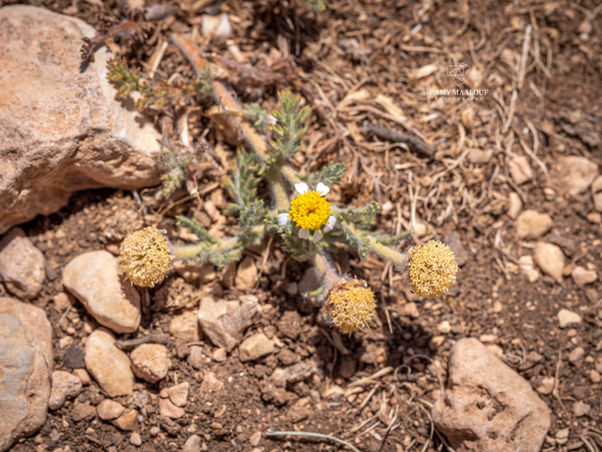Family |
Asteraceae
Anacyclus clavatus
(Desf.) Pers.
Anacyclus clavatus (Desf.) Pers.
≡ Anthemis clavata Desf.
≡ Anthemis tomentosa Gouan
(Syn. Pl. 2: 465, 1807; Nouvelle Flore du Liban et de la Syrie, vol. 3, p. 417; Pl. CCXXXI nº 1; 1983)
• Life-form & habit: Annual, pubescent or slightly villous herb, 20–40 cm, with erect, firm stems, often branched from the base.
• Leaves: Oblong in outline, bipinnatisect into narrow linear lobules; cauline leaves sessile, the lower lobules partially surrounding the stem.
• Inflorescence & flowers: Peduncles short, thickened at the apex. Involucre more or less villous; bracts obtuse, outer oblong, inner broader, often with a narrow scarious purple margin. Receptacle shortly conical, with flat scales, trapezoidal at base, triangular at apex, shortly mucronate, sometimes ciliate. Ligules oblong, white, generally shorter than the disc florets.
• Fruit: Achenes cuneiform, compressed, striate; outer ones with two broad white wings prolonged into a short erect auricle; intermediate ones narrowly winged; upper ones wingless, glabrous, truncate at apex.
• Phenology: Flowers April–May.
• Habitat & elevation: Adventive and ruderal; fields, roadsides, waste ground.
• Lebanese distribution: Rayak (Auriau), Taalabaya (Edg), Marjayyoun (Mt).
• Native range: Albania, Algeria, Baleares, Bulgaria, Canary Islands, Corse, France, Greece, Italy, Krym, Lebanon–Syria, Libya, Morocco, NW. Balkan Peninsula, Portugal, Sardegna, Sicilia, Spain, Tunisia, Turkey, Turkey-in-Europe (POWO).
• Introduced into: Belgium, Germany, Norway, Poland, Switzerland (POWO).





